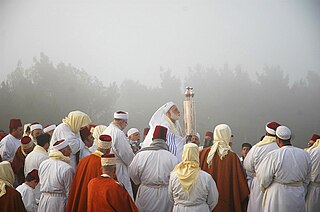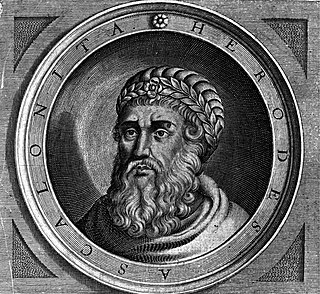Related Research Articles

Alfred the Great was King of Wessex from 871 to c. 886 and King of the Anglo-Saxons from c. 886 to 899. He was the youngest son of King Æthelwulf of Wessex. His father died when he was young and three of Alfred's brothers, Æthelbald, Æthelberht and Æthelred, reigned in turn.
Æthelberht was King of Kent from about 589 until his death. The eighth-century monk Bede, in his Ecclesiastical History of the English People, lists him as the third king to hold imperium over other Anglo-Saxon kingdoms. In the late ninth century Anglo-Saxon Chronicle, he is referred to as a bretwalda, or "Britain-ruler". He was the first English king to convert to Christianity.

The Kingdom of Israel and the Kingdom of Judah were related kingdoms from the Iron Age period of the ancient Levant. The Kingdom of Israel emerged as an important local power by the 10th century BCE before falling to the Neo-Assyrian Empire in 722 BCE. Israel's southern neighbor, the Kingdom of Judah, emerged in the 9th or 8th century BCE and later became a client state of first the Neo-Assyrian Empire and then the Neo-Babylonian Empire before a revolt against the latter led to its destruction in 586 BCE. Following the fall of Babylon to the Achaemenid Empire under Cyrus the Great in 539 BCE, some Judean exiles returned to Jerusalem, inaugurating the formative period in the development of a distinctive Judahite identity in the province of Yehud Medinata.
Saint Olga was a regent of Kievan Rus' for her son Svyatoslav from 945 until 960. Due to the imperfect transliteration between Old East Slavic and the English language, the name Olga is synonymous with Olha. Because of her Varangian origin, she also is known in Old Norse as Saint Helga. She is known for her obliteration of the Drevlians, a tribe that had killed her husband Igor of Kiev. Even though it would be her grandson Vladimir that would convert the entire nation to Christianity, because of her efforts to spread Christianity through Rus’, Olga is veneration as a saint in the Eastern Orthodox Church with the epithet "Equal to the Apostles" and her feast day is the 11th of July.

The Samaritans (; Samaritan Hebrew: ࠔࠠࠌࠝࠓࠩࠉࠌ, translit.Shamerim are an ethnoreligious group originating from the Israelites of the Ancient Near East.

Herod, also known as Herod the Great and Herod I, was a Roman client king of Judea, referred to as the Herodian kingdom. The history of his legacy has polarized opinion, as he is known for his colossal building projects throughout Judea, including his renovation of the Second Temple in Jerusalem and the expansion of the Temple Mount towards its north, the Tomb of the Patriarchs in Hebron, the construction of the port at Caesarea Maritima, the fortress at Masada, and Herodium. Vital details of his life are recorded in the works of the 1st century CE Roman–Jewish historian Josephus. Herod also appears in the Christian Gospel of Matthew as the ruler of Judea who orders the Massacre of the Innocents at the time of the birth of Jesus, although a majority of Herod biographers do not believe this event to have occurred. Despite his successes, including singlehandedly forging a new aristocracy from practically nothing, he has still garnered criticism from various historians. His reign polarizes opinion amongst scholars and historians, some viewing his legacy as evidence of success, and some as a reminder of his tyrannical rule.
The Pharisees were a social movement and a school of thought in the Holy Land during the time of Second Temple Judaism. After the destruction of the Second Temple in 70 CE, Pharisaic beliefs became the foundational, liturgical and ritualistic basis for Rabbinic Judaism.

The Cimmerians were a nomadic Indo-European people, who appeared about 1000 BC and are mentioned later in 8th century BC in Assyrian records. While the Cimmerians were often described by contemporaries as culturally "Scythian", they evidently differed ethnically from the Scythians proper, who also displaced and replaced the Cimmerians.

The Maccabees, also spelled Machabees, were a group of Jewish rebel warriors who took control of Judea, which at the time was part of the Seleucid Empire. They founded the Hasmonean dynasty, which ruled from 167 BCE to 37 BCE, being a fully independent kingdom from about 110 to 63 BCE. They reasserted the Jewish religion, partly by forced conversion, expanded the boundaries of Judea by conquest and reduced the influence of Hellenism and Hellenistic Judaism.

The Hasmonean dynasty was a ruling dynasty of Judea and surrounding regions during classical antiquity. Between c. 140 and c. 116 BCE the dynasty ruled Judea semi-autonomously from the Seleucids. From 110 BCE, with the Seleucid Empire disintegrating, the dynasty became fully independent, expanded into the neighbouring regions of Samaria, Galilee, Iturea, Perea, and Idumea, and took the title "basileus". Some modern scholars refer to this period as an independent kingdom of Israel.
The Christological argument for the existence of God, which exists in several forms, holds that if certain claims about Jesus are valid, one should accept that God exists. There are three main threads; the argument from the wisdom of Jesus, the argument from the claims of Jesus as son of God and the argument from the resurrection.

The Bosporan Kingdom, also known as the Kingdom of the Cimmerian Bosporus, was an ancient Greco-Scythian state located in eastern Crimea and the Taman Peninsula on the shores of the Cimmerian Bosporus, the present-day Strait of Kerch. It was the first truly 'Hellenistic' state in the sense that a mixed population adopted the Greek language and civilization. The Bosporan Kingdom became the longest surviving Roman client kingdom. The 1st and 2nd centuries BC saw a period of renewed golden age of the Bosporan state. It was a Roman province from 63 to 68 AD, under Emperor Nero. At the end of the 2nd century AD, King Sauromates II inflicted a critical defeat on the Scythians and included all the territories of the Crimea in the structure of his state.

The Phrygians were an ancient Indo-European people, initially dwelling in the southern Balkans – according to Herodotus – under the name of Bryges (Briges), changing it to Phryges after their final migration to Anatolia, via the Hellespont. However, the Balkan origins of the Phrygians are debated by modern scholars.

The Kingdom of Jimma was one of the kingdoms in the Gibe region of Ethiopia that emerged in the 19th century. It shared its western border with Limmu-Ennarea, its eastern border with the Sidamo Kingdom of Janjero, and was separated from the Kingdom of Kaffa to the south by the Gojeb River. Jimma was considered the most powerful militarily of the Gibe kingdoms. Dawro, an Ometo dialect, was the native language; it later slowly gave way to Oromo.
Aquilonia is a fictional country created by Robert E. Howard for the fictional character Conan the Barbarian, who eventually becomes its king. The mythical country existed during the Hyborian Age. Howard was precise concerning the geographic relationships between his fictional world and the real world, placing it in modern France and southern Britain, but left the origins of Aquilonia vague. In the real world, it was an ancient battle, and a Roman city. See Aquilonia. Stygia (Egypt) was far to the south in the Hyborian age.
Polemon Pythodoros, also known as Polemon I or Polemon I of Pontus was the Roman Client King of Cilicia, Pontus, Colchis and the Bosporan Kingdom. Polemon was the son and heir of Zenon and possibly Tryphaena. Zenon and Polemon adorned Laodicea with many dedicated offerings.
In Greek mythology, Antenor was a counselor to King Priam of Troy during the events of the Trojan War.

Daniel is the hero of the biblical Book of Daniel. A noble Jewish youth of Jerusalem, he is taken into captivity by Nebuchadnezzar of Babylon and serves the king and his successors with loyalty and ability until the time of the Persian conqueror Cyrus, all the while remaining true to the God of Israel. The consensus of modern scholars is that Daniel never existed, and the book is a cryptic allusion to the reign of the 2nd century BCE Greek king Antiochus IV Epiphanes.
Dynamis, nicknamed Philoromaios, was a Roman client queen of the Bosporan Kingdom during the Late Roman Republic and part of the reign of Augustus, the first Roman Emperor. Dynamis is an ancient Greek name which means the “powerful one”. She was a monarch of Iranian and Greek Macedonian ancestry. She was the daughter of King Pharnaces II of Pontus and his Sarmatian wife. She had an older brother called Darius and a younger brother called Arsaces. Her paternal grandparents had been the monarchs of the Kingdom of Pontus, Mithridates VI of Pontus and his first wife Laodice, who was also his sister. Dynamis married three times. Her husbands were Asander, a certain Scribonius and Polemon I of Pontus. According to Rostovtzeff, she also had a fourth husband, Aspurgos.

Ben & Holly's Little Kingdom is a British animated children's television series aimed at children originally broadcast on Nickelodeon UK.
References
- 1 2 3 Lewis, John (1729). The history of Great-Britain : from the first inhabitants thereof, 'till the death of Cadwalader, last king of the Britains. Printed for F. Gyles, Mess. Woodman and Lyon, and C. Davis.
- ↑ "European Kingdoms: The Franks". Kessler Associates. Retrieved 26 September 2013.